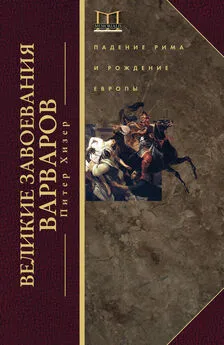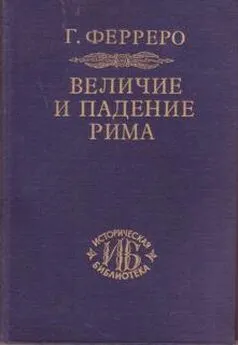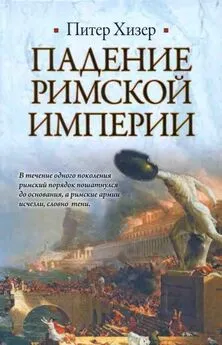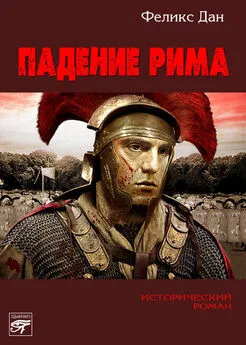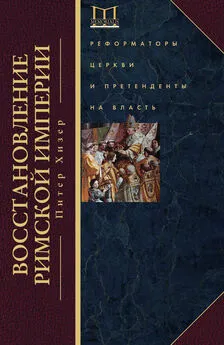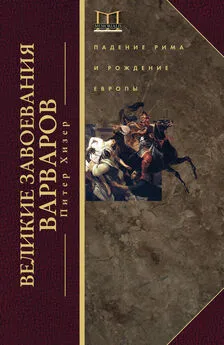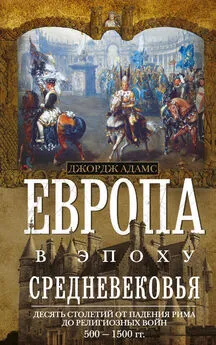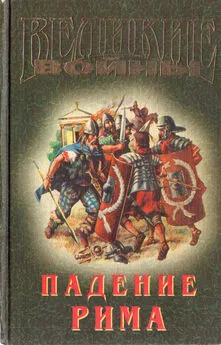Питер Хизер - Великие завоевания варваров. Падение Рима и рождение Европы
- Название:Великие завоевания варваров. Падение Рима и рождение Европы
- Автор:
- Жанр:
- Издательство:ЛитагентЦентрполиграфa8b439f2-3900-11e0-8c7e-ec5afce481d9
- Год:2016
- Город:М.
- ISBN:978-5-227-07057-9, 978-5-227-07058-6
- Рейтинг:
- Избранное:Добавить в избранное
-
Отзывы:
-
Ваша оценка:
Питер Хизер - Великие завоевания варваров. Падение Рима и рождение Европы краткое содержание
Книга Питера Хизера, авторитетного специалиста по истории раннего Средневековья, посвящена великому переселению народов в 1-м тысячелетии от Рождества Христова. Автор дает всестороннюю характеристику периода, ставшего ключевым для возникновения наций и создания первых государств франков, германцев, славян и других народов; анализирует модели и причины миграции в контексте преобразований, затронувших западную часть континента. Особое внимание Питер Хизер уделяет масштабной славянизации Центральной и Восточной Европы укреплению славянских государств, которые существуют по сей день. Отстаивая определяющую роль миграции в преображении варварской Европы, историк не умаляет важности внутренних экономических, социальных и политических трансформаций, а также взаимопроникновения культур, распространения христианства, письменности и ремесел. Описывая процесс рождения новой Европы, Питер Хизер убедительно доказывает, что миграция – ключевое явление 1-го тысячелетия, определившее современную карту мира.
Великие завоевания варваров. Падение Рима и рождение Европы - читать онлайн бесплатно ознакомительный отрывок
Интервал:
Закладка:
Hachmann, R. (1971). The Germanic Peoples (London)
Haldon, J.F. (1990). Byzantium in the Seventh Century: The Transformation of a Culture (Cambridge)
Hall, C. (1983). Periphrastic Do: History and Hypothesis (Ann Arbor)
Halsall, G. (1992). ‘The Origins of the Reihengr ä berzivilisation: Forty Years On’, in Drinkwater and Elton (1992), 196–207
– (1995a). Settlement and Social Organization: The Merovingian Region of Metz (Cambridge).
– (1995b). Early Medieval Cemeteries: An Introduction to Burial Archaeology in the Post-Roman West (Skelmorlie)
– (1999). ‘Movers and Shakers: The Barbarians and the Fall of Rome’, Early Medieval Europe 8, 131–145
– (2001). ‘Childeric’s grave, Clovis’ Succession and the Origins of the Merovingian Kingdom’, in Mathisen and Shanzer (2001), 116–133
– (2005). ‘The Barbarian Invasions’, in Fouracre (2005), 35–55
– (2007). Barbarian Migrations and the Roman West 376–568 (Cambridge)
Handley, M. (2001). ‘Beyond Hagiography: Epigraphic Commemoration and the Cult of the Saints in Late Antique Trier’, in Mathisen and Shanzer (2001), 187–200
– (2003). Death, Society and Culture: Inscriptions and Epitaphs in Gaul and Spain, AD 300–750 (Oxford)
Hannestad, K. (1960). ‘Les forces militaires d’apre`s la guerre gothique de Procope’, Classica et Mediaevalia 21, 136–183
Hansen, G.C., ed. (1995). Sokrates: Kirchengeschichte (Berlin)
Harhoiu, R. (1977). The Treasure from Pietroasa, Romania (Oxford)
H ä rke, H. (1989). ‘Early Saxon Weapon Burials: Frequencies, Distributions and Weapon Combinations’, in Chadwick-Hawkes (1989), 49–61
– (1990). ‘ “Warrior Graves?” The Background of the Anglo-Saxon Weapon Burial Rite’, Past and Present 126, 22–43
– (1992). Angelsächsische Waffengräber des 5. bis 7. Jahrhunderts (Cologne)
– (1998). ‘Archaeologists and Migrations: A Problem of Attitude?’, Current Anthropology 39.1, 19–45
Hart, C. (1992). The Danelaw (London)
Haubrichs, W. (1996). ‘Sprache und Sprachzeugnisse der merowingischen Franken’, in Die Franken: Wegbereiter Europas: vor 1500 Jahren, König Chlodwig und seine Erben (Mainz), 559–573
– (2003). ‘Remico aus Goddelau: Ostgermanen, Westgermanen und Romanen im Wormser Raum des 5./6. Jahrhunderts’, in Runica – Germanica – Mediaevalia , ed. W. Heizmann and A. van Nahl (Berlin), 226–242
– (forthcoming). ‘Ein namhaftes Volk: Burgundische Namen und Sprache des 5. und 6. Jahrhunderts’, in Die Burgunder: Ethnogenese und Assimilation eines Volkes , ed. V. Gall é e (Worms), 135–184
Heather, P.J. (1986). ‘The Crossing of the Danube and the Gothic Conversion’, Greek Roman and Byzantine Studies 27, 289–318
– (1988). ‘The Anti-Scythian Tirade of Synesius’ De Regno’, Phoenix 42, 152–172
– (1989). ‘Cassiodorus and the Rise of the Amals: Genealogy and the Goths under Hun Domination’, Journal of Roman Studies 79, 103–128
– (1991). Goths and Romans 332–489 (Oxford)
– (1993). ‘The Historical Culture of Ostrogothic Italy’, in Teoderico il grande e i Goti d’Italia, Atti del XIII Congresso internazionale di studi sull’Alto Medioevo (Spoleto), 317–353
– (1995a). ‘The Huns and the End of the Roman Empire in Western Europe’, English Historical Review 110, 4–41
– (1995b). ‘Theodoric King of the Goths’, Early Medieval Europe 4.2, 145–173
– (1996). The Goths (Oxford)
– (2001). ‘The Late Roman Art of Client Management and the Grand Strategy Debate’, in Pohl and Wood (2001), 15–68
– (2003). ‘Gens and regnum among the Ostrogoths’, in Goetz et al. (2003), 85–133
– (2005). The Fall of Rome: A New History (London)
– (2007). ‘Goths in the Roman Balkans c. 350–500’, in Poulter (2007), 163–190
– (2008a). Review of John Drinkwater (2007), Nottingham Medieval Studies 52, 243–245
– (2008b). ‘Ethnicity, Group Identity, and Social Status in the Migration Period’, in Garipzanov et al. (2008), 17–50
– (forthcoming). ‘Why Did the Barbarian Cross the Rhine?’, Late Antiquity
Heather, P.J. and Matthews, J.F. (1991). The Goths in the Fourth Century: Translated Texts for Historians (Liverpool)
Heather, P.J. and Moncur, D. (2001). Politics, Philosophy, and Empire in the Fourth Century: Select Orations of Themistius, Translated Texts for Historians (Liverpool)
Hedeager, L. (1987). ‘Empire, Frontier and the Barbarian Hinterland: Rome and Northern Europe from ad 1–400’, in Rowlands et al. (1987), 125–140
– (1988). ‘The Evolution of Germanic Society 1–400 ad’, in Jones R.F.J. et al. (1988), 129–144
– (1992), trans. John Hines. Iron-Age Societies: From Tribe to State in Northern Europe, 500 BC to AD 700 (Oxford)
Hedeager, L. and Kristiansen, K. (1981). ‘Bendstrup – A Princely Grave from the Early Roman Iron Age: Its Social and Historical Context’, Kuml (1981), 150–162
Helgason, A. et al. (2000). ‘Estimating Scandinavian and Gaelic ancestry in the male settlers of Iceland’, American Journal of Human Genetics 67, 697–717
– (2001). ‘mtDNA and the Islands of the North Atlantic: Estimating the Proportions of Norse and Gaelic Ancestry’, American Journal of Human Genetics 68, 723–737
– (2003). ‘A Reassessment of Genetic Diversity in Icelanders: Strong Evidence from Multiple Loci for Relative Homogeneity caused by Genetic Drift’, Annals of Human Genetics 67, 281–297
Henning, J. (1991). ‘Germanen-Slawen-Deutsche: Neue Untersuchungen zum fr ü hgeschichtlichen Siedlungswesen ostlich der Elbe’, Praehistorische Zeitschrift 66, 119– 133
– (2005). ‘Ways of Life in Eastern and Western Europe during the Early Middle Ages: Which Way was Normal?’, in Curta (2005), 41–59
Herrmann, J. (1968), Siedlung, Wirtschaft und gesellschaftliche Verhältnisse der slawischen Stamme zwischen Oder/Neisse und Elbe (Berlin)
– (1983), ‘Wanderungen und Landn ä hme im Westslawischen Gebiet’, in Settimane (1983), 75–101
– (1984), Germanen und Slawen in Mitteleuropa (Berlin)
Hermann, J. et al., eds. (1985). Die Slawen in Deutschland: Geschichte und Kultur der slawischen Stämme westlich von Oder und Neisse vom 6. bis 12. Jahrhundert , 2nd ed. (Berlin)
Higham, N. (1992). Rome, Britain and the Anglo-Saxons (London)
– (1994). The English Conquest: Gildas and Britain in the Fifth Century (Manchester)
–, ed. (2007). The Britons in Anglo-Saxon England (London) Hills, C. (2003). The Origins of the English (London)
Hines, J. (1984). The Scandinavian Character of Anglian England in the pre-Viking Period (Oxford)
–, ed. (1997). The Anglo-Saxons from the Migration Period to the Eighth Century: An Ethnographic Perspective (Woodbridge)
Hodder, I. (1982). Symbols in Action: Ethnoarchaeological Studies of Material Culture (Cambridge)
– (1991). Reading the Past: Current Approaches to Interpretation in Archaeology (Cambridge)
Hodder, I. and Hutson, S., eds. (2003). Reading the Past: Current Approaches to Interpretation in Archaeology (Cambridge)
Hodges, R. and Bowden, W., eds. (1998). The Sixth Century: Production, Distribution, and Demand (Leiden)
Hodgkin, T. (1886). The Letters of Cassiodorus: A Condensed Translation (London)
Holmes, C., ed. (1996). Migration in European History (Cheltenham)
Holt, J.C. (1987). ‘1086’ in Holt, ed., Doomsday Studies (Woodbridge), 41–64
Holtzmann, R., ed. (1935). Thietmari Merseburgensis episcopi chronicon , Monumenta Germaniae Historica: Scriptores rerum Germanicarum, vol. 9 (Berlin)
Hooke, D. (1997). ‘The Anglo-Saxons in England in the Seventh and Eighth Centuries: Aspects of Location in Space’, in Hines (1997), 65–99
– (1998). The Landscape of Anglo-Saxon England (London)
Hummer, H.J. (1998). ‘The Fluidity of Barbarian Identity: The Ethnogenesis of Alemanni and Suebi ad 200–500’, Early Medieval Europe 7, 2–26
Ilkjaer, J. (1995). ‘Illerup Adal (Danemark). Un lieu de sacrifices du IIIe si è cle de n. è . en Scandinavie meridionale’, in Vallet and Kazanski (1995), 101–112
Ilkjaer, J. and Lonstrup, J. (1983). ‘Der Moorfund im Tal der Illerup-A bei Skanderborg im Ostjutland’, Germania 61, 95–126
Ionita, I. (1975). ‘The Social-Economic Structure of Society During the Goths’ Migration in the Carpatho-Danubean Area’, in Constantinescu (1975), 77–89
James, E.F. (1988). The Franks (Oxford)
– (1989). ‘The Origins of Barbarian Kingdoms: The Continental Evidence’, in Bassett (1989), 40–52
James, S. (1999). The Atlantic Celts: Ancient People or Modern Invention? (London)
Jarnut, J. (2003). ‘Gens, Rex, and Regna of the Lombards’, in Goetz et al. (2003), 409–428
Jerome, H. (1926). Migration and Business Cycles (New York) Jirecek, H. (1867). Codex Juris Bohemici , vol. 1 (Prague) Johnston, D.E., ed. (1977). The Saxon Shore (London)
Jones, A.H.M. (1964). The Later Roman Empire: A Social Economic and Administrative Survey , 3 vols. (Oxford)
Jones, M.E. (1996). The End of Roman Britain (Ithica)
Jones R.F.J. et al., eds. (1988). First Millennium Papers: Western Europe in the First Millennium (Oxford)
Kaiser, D.H. (1980). The Growth of the Law in Medieval Russia (Princeton)
–, ed. (1992). The Laws of Rus’: tenth to fifteenth centuries (Salt Lake City)
Kaiser, D.H. and Marker, G., eds. (1994). Reinterpreting Russian History: Readings 860s—1860s (Oxford)
Kaiser, R. (1997). Die Franken: Roms Erben und Wegbereiter Europas? (Idstein)
Kantor, M. (1983). Medieval Slavic Lives of Saints and Princes (Ann Arbor)
– (1990). The Origins of Christianity in Bohemia (Evanston)
Kapelle, W.E. (1979). The Norman Conquest of the North: The Region and Its Transformation 1000–1135 (Chapel Hill, NC)
Kazanski, M. (1991). Les Goths (Ier—VIIe sie`cle apre`s J.-C.) (Paris)
– (1999). Les Slaves: les origines, Ier—VIIe siècle après J.-C. (Paris)
Kelly, C. (2008). Attila the Hun: Barbarian Terror and the Fall of Rome (London)
Kelly, G. (2008). Ammianus Marcellinus: The Allusive Historian (Cambridge)
Kennedy, H. (2004). The Court of the Caliphs: The Rise and Fall of Islam’s Greatest Dynasty (London)
– (2007). The Great Arab Conquests: How the Spread of Islam Changed the World We Live In (London)
Keydell, R., ed. (1967). Agathias Historiae, Corpus Fontium Historiae Byzantinae (Berlin)
Keynes, S. (1986). ‘A Tale of Two Kings: Alfred the Great and Aethelred the Unready’, Transactions of the Royal Historical Society 36, 195–217
– (1997). ‘The Vikings in England, c. 790–1016’, in Sawyer (1997a), 48–81
Keynes, S. and Lapidge, M., eds. (1983). Alfred the Great: Asser’s Life of King Alfred, and Other Contemporary Sources (London)
Читать дальшеИнтервал:
Закладка:
